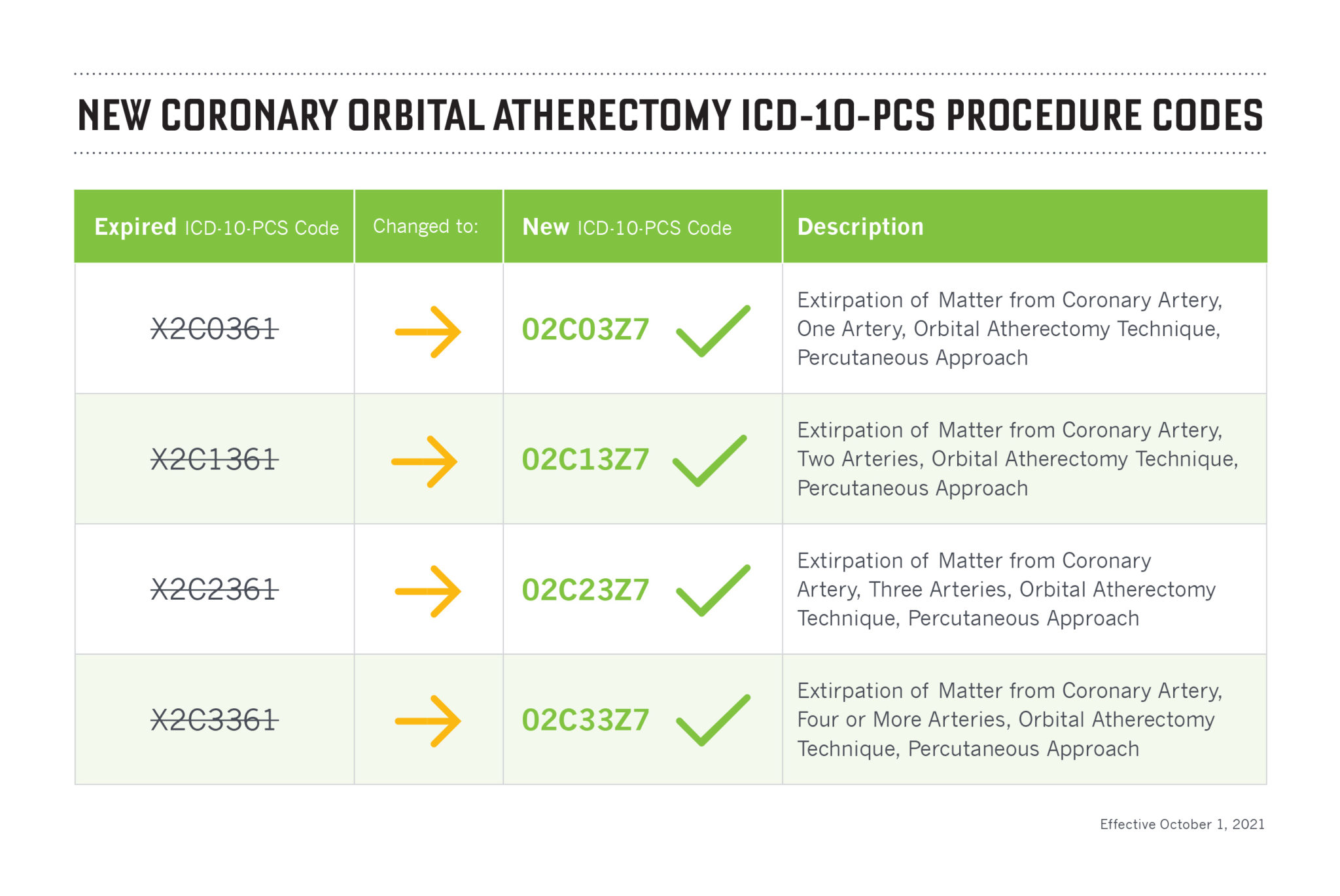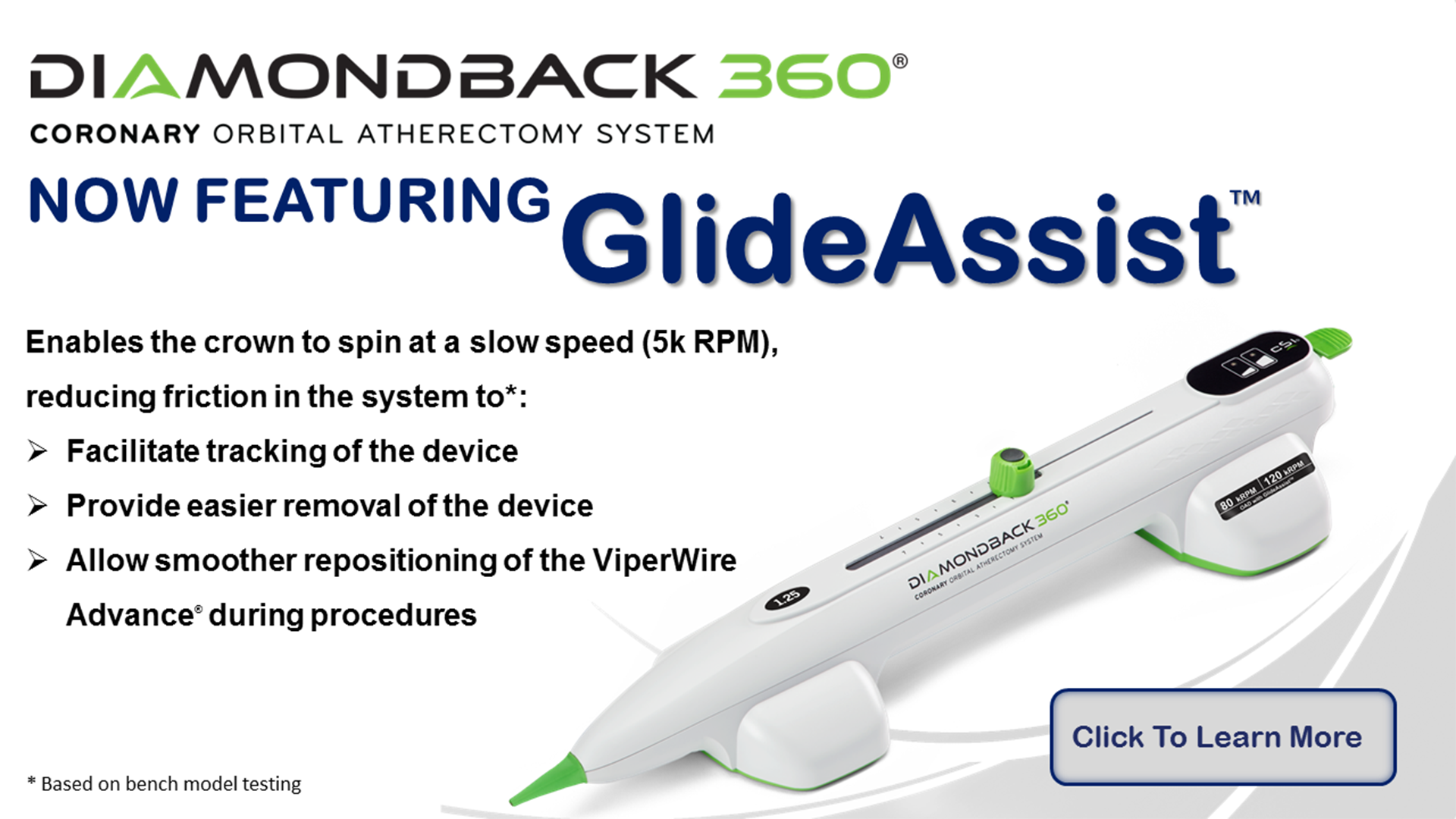-
-
-
- Mintz GS, et al. Patterns of calcification in coronary artery disease. A statistical analysis of intravascular ultrasound and coronary angiography in 1155 lesions. Circulation. 1995;91(7):1959-1965.
- Genereux P, et al. Ischemic outcomes after coronary intervention of calcified vessels in acute coronary syndromes. Pooled analysis from the HORIZONS-AMI (Harmonizing Outcomes with Revascularization and Stents in Acute Myocardial Infarction) and ACUITY (Acute Catheterization and Urgent Intervention Triage Strategy) TRIALS. J Am Coll Cardiol. 2014;63(18):1845-1854.
- Bourantas CV, et al. Prognostic implications of coronary calcification in patients with obstructive coronary artery disease treated by percutaneous coronary intervention: A patient-level pooled analysis of 7 contemporary stent trials. Heart. 2014;100(15):1158-1164.
- Chambers JW, Diage T. Evaluation of the Diamondback 360® Coronary Orbital Atherectomy System for treating de novo, severely calcified lesions. Expert Rev Med Devices. 2014;11(5): 457-466.
- Dattilo R, et al. The COMPLIANCE 360° Trial: a randomized, prospective, multicenter, pilot study comparing acute and long-term results of orbital atherectomy to balloon angioplasty for calcified femoropopliteal disease. J Invasive Cardiol. 2014;26(8):355-360.
- Shammas NW, et al. Comparison of orbital atherectomy plus balloon angioplasty vs. balloon angioplasty alone in patients with critical limb ischemia: results of the CALCIUM 360 randomized pilot trial. J Endovasc Ther. 2012;19(4):480-488.
- Chambers J, et al. The potential cost-effectiveness of the Diamondback 360 Coronary Orbital Atherectomy System for treating de novo, severely calcified coronary lesions: an economic modeling approach. Ther Adv Cardiovasc Dis. 2016;10(2):74-85.
- Généreux P, et al. Orbital atherectomy for treating de novo severely calcified coronary narrowing (1-year results from the pivotal ORBIT II trial). Am J Cardiol. 2015;115(12):1685-1690.
- Kashyap VS, et al. Angiography underestimates peripheral atherosclerosis: lumenography revisited. J Endovasc Ther. 2008;15(1):117-125.
- Chambers JW, et al. Pivotal trial to evaluate the safety and efficacy of the orbital atherectomy system in treating de novo, severely calcified coronary lesions (ORBIT II). JACC Cardiovasc Interv. 2014;7(5):510-518.
- Weinstock B, et al. Cost-effectiveness analysis of orbital atherectomy plus balloon angioplasty vs balloon angioplasty alone in subjects with calcified femoropopliteal lesions. Clinicoecon Outcomes Res. 2014;6:133-139.
- Allie DE, et al. Critical limb ischemia: a global epidemic. A critical analysis of current treatment unmasks the clinical and economic costs of CLI. EuroIntervention. 2005;1(1):75-84.
- Yost ML. Peripheral arterial Disease: a report by the Sage Group http://www.businesswire.com/news/home/20170519005456/en/SAGE-GROUP-Peripheral-Artery-Disease-PAD-Afflicts. Accessed February 2020.
- Yost ML. The Economic Cost of PAD, CLI & Venous Disease: How Big is the Market? Presented at NCVH 2017.
- Rosamond W, et al. Heart disease and stroke statistics — 2007 update: a report from the American Heart Association Statistics Committee and Stroke Statistics Subcommittee. Circulation. 2007;115(5):e69-e171.
- Margolis J, et al. Health Care Resources and Costs for Treating Peripheral Artery Disease in a Managed Care Population: Results from Analysis of Administrative Claims Data. J Manag Care Pharm. 2005;11(9):727-734.
- Mahoney EM, et al. One-Year Costs in Patients With a History of or at Risk for Atherothrombosis in the United States. Circ Cardiovasc Qual Outcomes. 2008;1(1):38-45.
- Garrison LP, et al. The clinical and cost burden of coronary calcification in a Medicare cohort: an economic model to address under-reporting and misclassification. Cardiovasc Revasc Med. 2015;16(7):406-412.
- Kugelmass AD, et al. Hospital resources consumed in treating complications associated with percutaneous coronary interventions. Am J Cardiol. 2006;97(3):322-327.
- Go AS, et al. Heart Disease and Stroke Statistics – 2014 Update: A report from the American Heart Association. Circulation. 2014;129(3):e28-e292.
- Howlader N, et al. SEER Cancer Statistics Review, 1975-2010. National Cancer Institute.
- Schiavetta A, et al. A Phase II trial of autologous transplantation of bone marrow stem cells for critical limb ischemia: Results of the Naples and Pietra Ligure Evaluation of Stem Cells Study. Stem Cells Transl Med. 2012;1(7):572-578.
- U.S. Department of Health & Human Services; National Institute of Health; National Heart, Lung, and Blood Institute. http://www.nhlbi.nih.gov/health/educational/pad/materials/pad_extfctsht_general.html. Accessed February 2020.
- Aboyans V, et al. Risk factors for progression of peripheral arterial disease in large and small vessels. Circulation. 2006;113(22):2623-2629.
- Graziani L, Piaggesi A. Indications and clinical outcomes for below knee endovascular therapy: Review article. Catheter Cardiovasc Interv. 2010;75(3):433–443.
- CDC, NCHS. Underlying Cause of Death 1999-2018 on CDC WONDER Online Database, released 2015. Data are from the Multiple Cause of Death Files, 1999-2018, as compiled from data provided by the 57 vital statistics jurisdictions through the Vital Statistics Cooperative Program. https://wonder.cdc.gov/wonder/help/ucd.html. Accessed February 2020.
- Rozzi JA, et al. Racial Disparities in Amputation Rates for Patients with Peripheral Artery Disease: Long-Term Trends and Projections. Poster presented at ISPOR 2016 (Figure 2).
- Mustapha JA, et al. Explaining racial disparities in amputation rates for the treatment of peripheral artery disease (PAD) using decomposition methods. J Racial Ethn Health Disparities. 2017;4(5):784-795.
- Rizzo JA, et al. Racial disparities in amputation rates for the treatment of peripheral artery disease using the Health Care Cost and Utilization Project Database. Value in Health. 2016;19(3):A55-A56.
- Fitzgerald PJ, et al. Contribution of localized calcium deposits to dissection after angioplasty. An observational study using intravascular ultrasound. Circulation. 1992;86(1):64-70.
- Makam P. Use of orbital atherectomy treatment in a high-volume clinical practice modifies non-compliant plaque to deliver durable long-term results. J Invasive Cardiol. 2013;25(2):85-88.
- Pearce BJ, Toursarkissian B. The current role of endovascular intervention in the management of diabetic peripheral arterial disease. Diabet Foot Ankle. 2012;3:10.3402/dfa.v3i0.18977.
- Scheinert D. Calcification in the SFA: Clinical Relevance for Acute and Long-Term Outcomes and Treatment Approaches. Presented at TCT 2008.
- Criqui, M, Aboyans V. Epidemiology of peripheral artery disease. Circ Res. 2015;116(9):1509-1526.
- Das T, et al. Technique optimization of orbital atherectomy in calcified peripheral lesions of the lower extremities: the CONFIRM series, a prospective multicenter registry. Catheter Cardiovasc Interv. 2014;83(1):115-122.
- Panayiotopoulos YP, et al. Results and cost analysis of distal [crural/pedal] arterial revascularisation for limb salvage in diabetic and non-diabetic patients. Diabet Med. 1997;14(3):214-220.
- Alonso A, Garcia LA. The costs of critical limb ischemia. Endovasc Today. 2011;August:32-36.
- Mozaffarian D, et al. Heart disease and stroke statistics—2016 update. Circulation, 2016:133(4), e38-e360.
- Roger VL, et al. Heart disease and stroke statistics–2012 update: a report from the American Heart Association. Circulation. 2012;125(1):e2-e220.
- Warning Signs of a Heart Attack; American Heart Association. http://www.heart.org/HEARTORG/Conditions/HeartAttack/WarningSignsofa%20HeartAttack/Warning-Signs-of-a-Heart-Attack_UCM_002039_Article.jsp. Accessed February 2020.
- CMS.gov. Better Care. Smarter Spending. Healthier People: Paying Providers for Value, Not Volume. CMS Fact Sheet. 2015.
- Herman B, Evans M. Where healthcare is now on march to value-based pay. Modern Healthcare. 2015.
- Benjamin E, et al. Heart Disease and Stroke Statistics 2017 Update: A Report from the American Heart Association. Circulation. 2017;135(10):e146-e603.
- Mintz GS. Intravascular imaging of coronary calcification and its clinical implications. JACC Cardiovascular Imaging. 2015;8(4):461-471.
- Babaev A, et al. Orbital atherectomy plaque modification assessment of the femoropopliteal artery via intravascular ultrasound (TRUTH Study). Vasc Endovascular Surg. 2015;49(7):188-194.
- Lee M, et al. Orbital atherectomy for treating de novo, severely calcified coronary lesions: 3-year results of the pivotal ORBIT II trial. Cardiovasc Revasc Med. 2017;18(4):261-264.
- Noone AM, et al. SEER Cancer Statistics Review, 1975-2015, National Cancer Institute. Bethesda, MD.
- Yost M. United States Critical Limb Ischemia by Rutherford Category: Prevalence and Markets in Patients and Limbs. The Sage Group. Beaufort, SC, 2017.
- Nehler MR, et al. Epidemiology of peripheral arterial disease and critical limb ischemia in an insured national population. J Vasc Surg. 2014;60(3):686-695.e2.
- Adams GL, et al. Optimal techniques with the Diamondback 360 System achieve effective results for the treatment of peripheral artery disease. J Cardiovasc Transl Res. 2011;4(2):220-229.
- Shlofmitz E, et al. Orbital atherectomy for the treatment of severely calcified coronary lesions: evidence, technique, and best practices. Expert Rev Med Devices. 2017;14(11):867-879.
- Yamamoto M, et al. Effect of orbital atherectomy in calcified coronary artery lesions as assessed by optical coherence tomography. Catheter Cardiovasc Interv. 2018;93(7):1211-1218.
- CSI data on file: based on cadaver atheroschlerotic lesions, porcine coronary lesions and graphite block test models.
- Allie DE, et al. 24-carat gold, 14-carat gold, or platinum standards in the treatment of critical limb ischemia: Bypass surgery or endovascular intervention? J Endovasc Ther. 2009;16(Suppl I):I134-I146.
- The Sage Group. http://thesagegroup.us/pages/news/pad-aware-2015.php. Accessed February 2020.
- Heidenreich PA, et al. Forecasting the future of cardiovascular disease in the United States: A policy statement from the American Heart Association. Circulation. 2011;123(8):933-944.
- Chambers J, et al. Orbital Atherectomy Treatment of De Novo, Severely Calcified Coronary Lesions: Two-Year Results of the ORBIT II trial. Presented at EuroPCR 2015 and Data on file at CSI.
- Shammas N, et al. Hospital cost impact of orbital atherectomy with angioplasty for critical limb ischemia treatment: A modeling approach. J Comp Eff Res. 2018;7(4):305-317.
- Shlofmitz E, et al. Lesion preparation with orbital atherectomy. Interv Cardiol. 2019;14(3):169-173.
- Lee MS, et al. Real-world multicenter registry of patients with severe coronary artery calcification undergoing orbital atherectomy. J Interv Cardiol. 2016;29(4):357-362.
- Kini A, et al. Optical coherence tomography assessment of the mechanistic effects of rotational and orbital atherectomy in severely calcified coronary lesions. Catheter Cardiovasc Interv. 2015;86(6):1024-1032.
- Shlofmitz E, et al. Orbital atherectomy: A comprehensive review. Interv Cardiol 2019;14(3):169–173.
-
-




